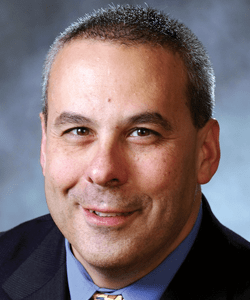Tobacco use has been cited as the top cause of preventable death and disability in the United States. However, tobacco control and treatment are not commonly addressed by physicians in their daily practices, according to Frank T. Leone, MD, MS. “To help close the gap,” he says, “the Tobacco Action Committee of the American Thoracic Society (ATS) developed a research statement to summarize current understanding about the mechanisms available to address the tobacco use epidemic. The document also provides clinicians with the tools needed to address the issue in their own practices and communities.”
A Look to the Future
The ATS statement, published in the American Journal of Respiratory and Critical Care Medicine, includes recommendations that look to the future and point to the types of questions that clinicians should be asking themselves, says Dr. Leone, who was lead author of the statement. The statement also challenges clinicians to consider the social constructs responsible for the propagation of tobacco dependence as an epidemic, according to Dr. Leone. “We wanted to highlight how dependence as an illness is moving through the population in manners that are very reminiscent of an epidemic,” he says. “We also thought it was important to provide an update on treatment strategies and the biological basis of dependence, why some medications work for achieving cessation and others don’t, how these medications are most effectively used, and some of the important questions that remain unanswered.”
According to Dr. Leone, the most important of these unanswered questions is how to conceptually transition tobacco dependence treatment away from a smoking cessation model, in which patients are either successful or fail, to a chronic disease model that requires long-term control over the compulsion to smoke. “We don’t think of other chronic illness, like asthma, in terms of success or failure,” he says. “We’ve developed well-validated outcome measures that help explain the degree to which the underlying illness is being controlled. Thinking differently about tobacco dependence could lead to the development of these same kinds of control outcome measures.”
Consider Components Collectively
According to Dr. Leone, each of the components in the management of tobacco dependence need to be considered collectively. “The answer is not tobacco control or tobacco dependence treatment or cultural and environmental modification or policy modification,” he says. The ‘ors’ should be replaced with ‘ands.’ The relationships between issues such as leveraging changes in our understanding of treatment to influence policy, changing policy in order to influence the likelihood that people will pick up cigarettes in the first place, and influencing the biology of initiation such that it becomes easier to help people stop smoking in the future are most important in addressing the epidemic.”
In seeking these changes, Dr. Leone suggests that clinicians use the information within the ATS statement as fodder for conversations with patients about the complexity of tobacco dependence. “Patients with providers who discuss tobacco dependence with them in a non-pejorative, non-judgmental way are more likely to seek treatment and attempt to modify their behavior,” he says. “We hope that the statement energizes clinicians to look to the future for creative approaches to help solve the issue.”
Frank T. Leone, MD, MS, is a Senior Fellow in the Leonard Davis Institute of Health Economics of the Wharton School, and the Director of Comprehensive Smoking Treatment Programs at the University of Pennsylvania. He is also an Associate Professor of Medicine at the Perelman School of Medicine.
Frank T. Leone, MD, MS, has indicated to Physician’s Weekly that he has no financial interests to disclose.



 PWeekly
PWeekly